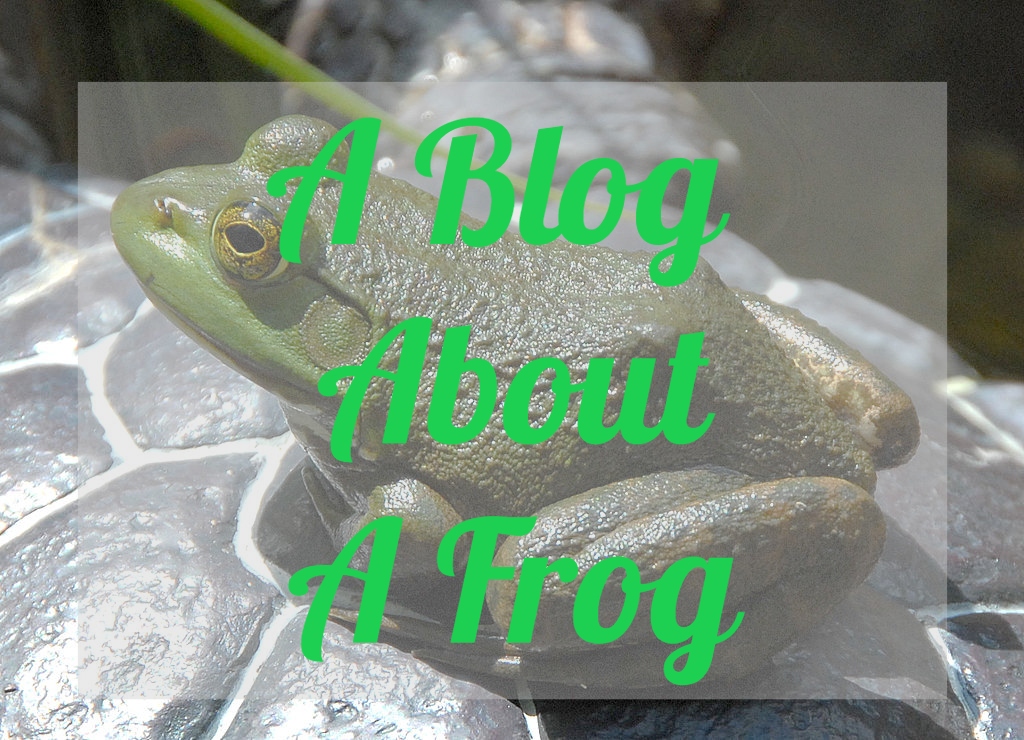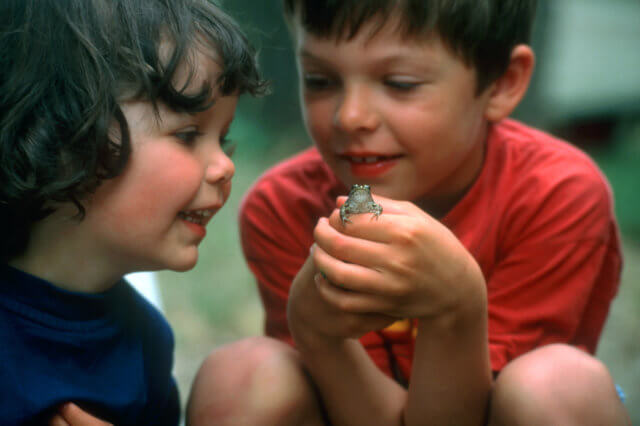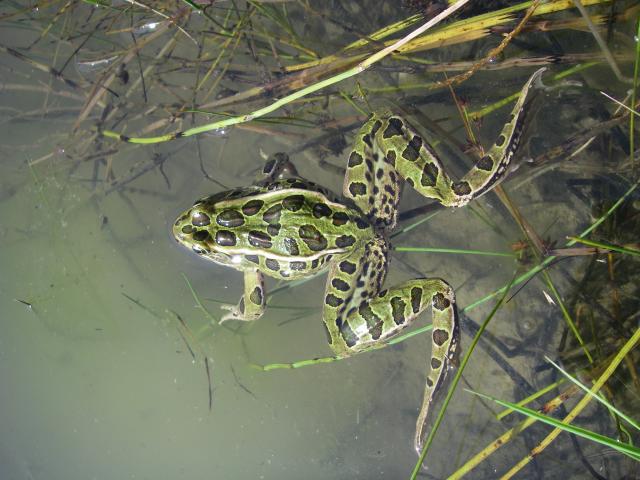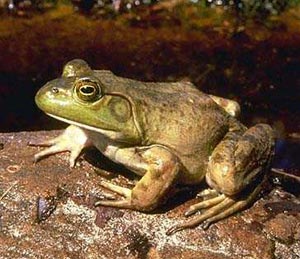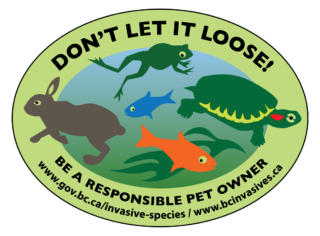The American bullfrog is listed as one of the 100 worst invasive species internationally! Sadly, bullfrogs have ended up in the Central Kootenay region. Here is everything you need to know about the extremely invasive American bullfrog.
Where are bullfrogs originally from?
Bullfrogs are native to eastern North America. They are found in southern Ontario east through southern Nova Scotia and south to northern Florida and west to Texas. In these locations they are part of the natural food web and have predators to keep their populations in check.
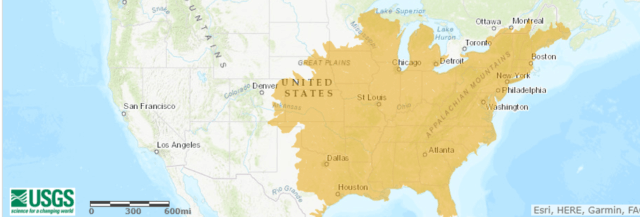
Where have American bullfrogs spread?
Bullfrogs have been widely distributed around the globe to over 40 countries and four continents. BC’s most infested areas are found on Vancouver island and along the west coast. Local infestations can be found in the Creston Valley and Salmo area.

How did bullfrogs end up in B.C.?
Decades ago, aspiring farmers brought America bullfrogs to B.C. to raise them for meat consumption. How often do you see frog legs on a menu or in the grocery store? Rarely to never. The frog leg industry never took off and these farmers released the frogs into the natural world. This simple act has since caused complicated impacts.
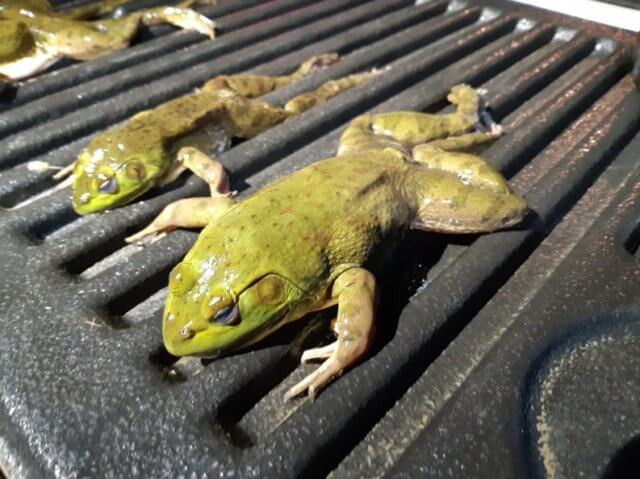
How are bullfrogs spreading in B.C.?
- The pet trade is guilty of spreading American bullfrogs not only in B.C. but globally! Around the world, they are found for sale in pet stores and markets. People who can no longer care for their pet bullfrog sometimes ‘dump’ them into the wild.
- Curious kids love frogs! Little naturalists enjoy capturing a tadpole in nature and bringing it home to watch it transform into a frog. What ends up happening is the frog is released into a different body of water, creating a NEW invasive bullfrog population.
- Natural migration: bullfrogs can naturally migrate between 5 – 19 km per year.

Kids have been known to move frogs and tadpoles around from one body of water to another. Consequences of invasion
- Voracious predator that eats anything that fits into its mouth! Bullfrogs prey on, out-compete, native frog species, including the endangered Northern Leopard Frog and the protected Pacific Chorus Frog and Columbia Spotted Frog. The only population of Northern Leopard Frogs in the Northern Rockies is in Creston… and they are now threatened by Bullfrogs!
- Can spread the chytrid fungus, which is responsible for declining amphibian populations.
- Bullfrogs reproduce up to 10 times faster than native frog species, pushing them out of preferred habitats.
- Tadpoles act as “ecosystem engineers”, meaning they are extremely competitive and take food and habitat away from native frogs.
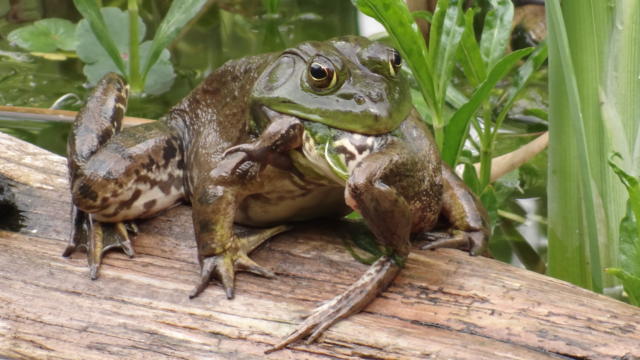
Why are native frogs important?
- Frogs are an integral part of the food web. Adult frogs eat large quantities of insects, including disease vectors that can transmit illnesses to humans (i.e. mosquitoes/malaria). Frogs and tadpoles also serve as an important food source to a diverse array of predators, including dragonflies, fish, snakes, birds, beetles, and centipedes.
- Tadpoles keep waterways clean by feeding on algae.
- The disappearance of frog populations results in negative impacts that cascade through the ecosystem!

The native northern leopard frog is a species at risk that could be in danger if bullfrogs move into their pond! photo credit : B.Houston What do American bullfrogs look like?
- A large robust frog reaching up to 20 cm in length and up to 800 g in weight
- Wide flat head and smooth skin with no wrinkles, warts or spikes
- Bullfrogs colour varies from pale green to dark olive and can have brown spots
- Males have bright yellow throats during breeding season whereas females have pale cream to white throats
- They have large golden eyes
- Mature males have eardrums (circular spot behind eye) twice the diameter of the eye, mature females have eardrums about the same diameter as the eye
- Tadpoles are greenish yellow with small spots, growing up to 15 cm

The American bullfrog is the largest frog in North America. What does an American bullfrog sound like?
Males make a distinct call during mating season to establish territory and attract females. Click on the link below to listen to it’s unique call.
When and where were American bullfrogs detected in the Central Kootenay region?
Thanks to our friends at the Fish and Wildlife Compensation Program who warned us about the close proximity of American bullfrogs just south of the border (in 2013). This initiated American bullfrog field work.
- 2014: Northern Leopard Frog Recovery Team & CKISS installed, monitored and analyzed acoustic surveillance equipment called ‘Song Meters’ in Creston = no bullfrogs detected!
- 2015: CKISS continues surveillance work and installed more song meters. Bullfrogs confirmed in Nelway.
- 2016: Bullfrogs confirmed in Creston. Along with traditional surveillance tools, CKISS staff also utilized eDNA sampling, a cutting-edge technology that can be used for early detection of American bullfrogs.
- 2017: Field work confirms that Bullfrogs have dispersed into the Creston region.
- 2018 : CKISS along with the American Bullfrog Action Team conducted field work for early detection and eradication of invasive American bullfrogs. The bullfrog action team began monitoring and eradication efforts in June and wrapped up field work at the end of October. The team caught 672 bullfrogs, the largest weighing in at 200 grams.
- 2019: The field work for bullfrog control is now being coordinated by the Ministry of Forests, Lands, Natural Resource Operations and Rural Development (MFLNRORD) with support from CKISS. The field crew worked long night shifts from May 14 until the season was cut short due to cold weather on October 4. The crew focused most of their attention along the Kootenay River and were successful in euthanizing a total of 1732 invasive frogs this season.

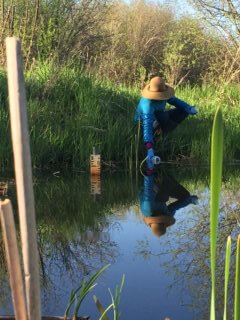

How can you help prevent the spread of American bullfrogs?
- Do NOT purchase bullfrogs as pets.
- Never release bullfrogs into the wild – Don’t Let it Loose!
- Do NOT transport wild bullfrogs or tadpoles from place to place, it is illegal under the Wildlife Act to capture, transport, keep or sell wild animals including bullfrogs.
- Large tadpoles can be a tempting pet or a popular addition to your backyard pond, but this has been identified as a primary way bullfrogs have been spreading through the province.
“Build it and they will come!” If you want native frogs in your backyard pond the best thing to do is create a welcoming environment for the frogs: water, shelter and insects.
Don’t Let it Loose! 
If YOU see or hear a bullfrog report it!
- Phone: 1-250-354-6333
- Fax: 1-250-354-6332
- Email: kootenaybullfrog@gov.bc.ca
This program is made possible with the support of many partners and funders!
- Central Kootenay Invasive Species Society gratefully acknowledges the financial support of the Fish and Wildlife Compensation Program for its contribution to the Northern Leopard Frog Preservation American Bullfrog Control. www.fwcp.ca
- Columbia Basin Trust
- Partners on the project are MFLNRORD and the Ktunaxa Nation/ Yakan Nukiy Band, with funding from the Environmental Damages Fund (EDF) and the Aboriginal Fund for Species At Risk (AFSAR), both through Environment and Climate Change Canada. Funding is also being provided by the US Fish and Wildlife Service (USFWS), with support from the Washington Department of Fish and Wildlife (WDFW) and Idaho Department of Fish and Game (IDFG)
- Nature Conservancy of Canada

